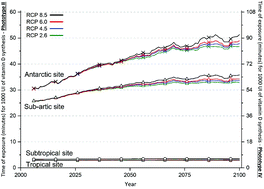Changes in the total ozone content over the period 2006 to 2100 and the effects on the erythemal and vitamin D effective UV doses for South America and Antarctica
Abstract
Recent studies show that the ozone layer will recover by the middle part of this century. This is a significant result arising from the Montreal Protocol, and highlights the success of this environmental protection agreement. Climate change projections show that Total Ozone Content (TOC) levels will increase significantly by the end of this century, mainly at higher latitudes. This increase may result in a reduction of the adverse effects of UV radiation overexposure. By contrast, reduced UV radiation levels at the surface of the Earth can result in reduced levels of vitamin D synthesis among the inhabitants of these regions. In this study we provide estimates for the UVI, erythemal, and vitamin-D weighted daily doses for ten different locations in South America and Antarctica. Our calculations were based on ozone projections provided by climate models set forth in the last IPCC report. Results show that the increase of TOC levels in middle and high latitude regions may result in decreased UVI and UV doses throughout the century. In high latitudes, erythemal doses and vitamin D synthesis doses may be reduced by up to 22 and 39%, respectively, if anthropogenic emissions continue to rise throughout the century. Furthermore, there may be reductions of up to 9 and 12%, respectively, in mid-latitudes (20°S to 35°S). Significant variations at Equatorial sites were not observed. In most of South America, the attenuation in UVR caused by increases in TOC during the 21st century is neither enough to promote protective effects from this radiation, nor for the lack of UVR for vitamin D synthesis. The incidence of UVR in tropical and sub-tropical areas of the continent will continue to be a public health risk for the entire 21st century during all seasons, regardless of the climatic scenarios. Our results can be used as an important tool for health studies focusing on the excess and/or lack of sun exposure.



 Please wait while we load your content...
Please wait while we load your content...